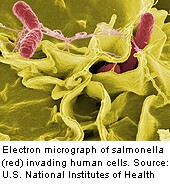
TUESDAY, June 7 (HealthDay News) — As a deadly new strain of E. coli in Europe makes headlines, U.S. health officials announced Tuesday that salmonella, not E. coli, remains the biggest foodborne health threat to Americans.
In fact, while rates of several types of foodborne illness — including E. coli — have been falling over the past 15 years, there’s been no progress against salmonella infections, according to the U.S. Centers for Disease Control and Prevention.
While infections from Shiga toxin-producing E. coli O157 (the strain of most concern in the United States) have dropped almost in half and the rates of six other foodborne infections have been cut 23 percent, salmonella infections have risen 10 percent, the agency said.
“There are about 50 million people each year who become sick from food in the U.S. That’s about one in six Americans,” CDC director Dr. Thomas R. Frieden said during a noon press conference Tuesday.
In addition, about 128,000 people are hospitalized and about 3,000 die from foodborne illnesses each year, he added.
“We need to do more, because foodborne illnesses are too common,” Frieden said.
The CDC’s report on foodborne illness is timely in light of the deadly E. coli outbreak in Germany, which has already sickened more than 2,200 and caused 22 deaths. The E. coli found in Germany is a cousin to E. coli O157 found in the United States. Both produce the Shiga toxin that can cause kidney failure and death.
This new report from the CDC includes data from the 2010 CDC’s Foodborne Diseases Active Surveillance Network, called FoodNet, which collects data on laboratory confirmed cases of foodborne illness.
In 2010, there were 20,000 illnesses, 4,200 hospitalizations and 68 deaths from nine types of foodborne infections, reported via FoodNet.
Of those, salmonella accounted for 8,200 infections, including 2,300 hospitalizations and 29 deaths. That’s 54 percent of all hospitalizations and 43 percent of the deaths reported through FoodNet, according to the CDC.
And that’s likely just the tip of the iceberg, because for every laboratory-confirmed case of salmonella there are at least 29 unreported cases, the agency says.
Speaking at the press conference, Michael R. Taylor, Deputy Commissioner for Foods at the U.S. Food and Drug Administration, said that “by implementing the new Shell-Egg Safety Rule, we expect the rule to reduce the number of salmonella infections for eggs by nearly 60 percent.”
However, at its best, that would still only translate to a reduction of about 10 percent of all salmonella cases, Frieden noted.
On the positive side, the rate of E. coli O157 cases, which can be a deadly infection have been cut in half over the past 15 years. This strain, affected two in every 100,000 people in 1997, had dropped to 0.9 cases per 100,000 by 2010, the CDC noted.
This reduction in infections from E. coli O157 is largely due to to better detection and investigation of outbreaks, cleaner slaughterhouse methods, better testing of ground beef for E. coli, improved inspections of ground beef processing plants, regulations prohibiting E. coli O157 in ground beef and increased awareness of the importance of properly cooking beef, the agency said.
Other foodborne illnesses that fell in incidence over the same time period include those caused by the campylobacter, listeria, vibrio and yersinia pathogens.
To reduce their risk of foodborne illness, people should assume that raw chicken and other meat have bacteria that can make you sick. In the kitchen, raw meats should not allow to contaminate counter tops or cutting boards and should be kept away from other foods, such as fruits and vegetables, the CDC advises.
In addition, while washing fruits and vegetables is important, meat and poultry should never be washed, Also, meat, poultry, eggs and shellfish should be cooked thoroughly. And, one should not drink unpasteurized milk and juice and not eat unpasteurized soft cheese, the CDC says.
Commenting on the CDC report, infectious disease expert Dr. Marc Siegel, an associate professor of medicine at New York University in New York City, said that “although there has been some progress, foodborne illness is still a major problem.”
These infections often spring from livestock, Siegel said, “and we create the problem by the way the animals are bred and fed,” he said. “We generate the salmonella problem with the way we raise chickens.”
“They are compressed in cages standing in their own poop,” Siegel said. “They are raised in squalid conditions that breeds salmonella.”
The only way to effectively decrease salmonella infection is to vaccinate chickens against the bacteria and pasteurize eggs, he said.
In addition, cattle are fed grain, which breeds bacteria such as E. coli, he added. On top of that, livestock are often given vast amounts of antibiotics, which can create antibiotic-resistant strains of bacteria, he said.
Siegel noted that bacterial contamination of produce usually comes from animal waste, which then contaminates water used to irrigate fruits and vegetables.
“It’s easy to teach people how to barbecue properly, but how about getting the bugs out of the meat in the first place?” he said.
Until food production practices are improved there will be more outbreaks of foodborne illness, Siegel said. “Outbreaks are inevitable,” he said.
More information
For more information on foodborne illness, visit the U.S. Centers for Disease Control and Prevention.

